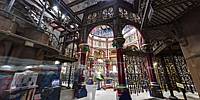© 2012 John Wilson, All Rights Reserved.
Joseph Bazalgette, Chief Engineer to the Metropolitan Commission of Sewers, was tasked with the construction of main sewers north and south of the Thames to intercept the many existing smaller sewers which ran into the river. The new intercepting sewers carried sewage eastwards to outfalls at Beckton in the north and Crossness in the south. At Crossness Pumping Station, four large steam-driven pumping engines were used to pump sewage up from the Southern Outfall Sewer into a 27 million gallon reservoir where the sewage was stored before being discharged into the Thames during ebb tide.
In December 1980 the buildings and engines were awarded Grade 1 listed status, and in 1987 the Crossness Engines Trust was set up to restore this outstanding example of Victorian engineering. The pumping engines are thought to be the largest remaining rotating beam engines in the world.
More information about the history and restoration of Crossness Pumping Station including visitor open days can be found here.



 Tap or click the zoom icon in the bottom right corner of the picture to switch between in-page and fullscreen view
Tap or click the zoom icon in the bottom right corner of the picture to switch between in-page and fullscreen view